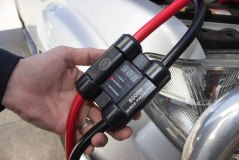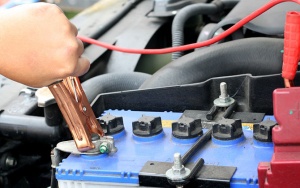In order to have a proper working vehicle, your battery needs to be in good working order as well. Having clean connections and a fully charged battery is a benefit for you as well as your vehicle. Without the battery, power cannot be supplied to the areas of your vehicle that need it in order to run properly. If the battery is dead, your vehicle will not even start. There are some signs to be on the lookout for to tell when your battery is starting to wear out. If you vehicle is getting harder and slower to start, it may be a sign that you will need a new battery soon. Testing a battery is a simple procedure that can be done during your regularly scheduled maintenance inspection.
 REGULAR INSPECTION & MAINTENANCE OF YOUR BATTERY
REGULAR INSPECTION & MAINTENANCE OF YOUR BATTERY
Use the following as a guide when examining your battery:
- Ensure the battery top is clean and dry, free of dirt and grime. A dirty battery can discharge across the grime on top of the battery casing.
- Inspect the terminals, screws, clamps and cables for breakage, damage or loose connections. These should be clean, tight and free of corrosion.
- Apply a thin coating of high temperature grease to posts and cable connections for added protection.
- Inspect the battery case for obvious signs of physical damage or warpage. This usually indicates the battery has overheated or has been overcharged.
- Check electrolyte levels to ensure that fluid levels are over the top of battery plates. If necessary top up using distilled or demineralised water. Never top up fluid levels with acid.
- Test the battery using either a hydrometer or voltmeter and charge if necessary.
BATTERY TESTING
Battery testing should form part of a regular maintenance routine. Pre-emptive battery replacement can help eliminate many of the costs and problems associated with a flat battery.
Voltage and Specific Gravity
Testing Methods
Unloaded Testing
Low Load Testing
 BATTERY CHARGING
BATTERY CHARGING
- Turn the charger off before attaching, rocking or removing the terminal clamps.
- Keep open flames and sparks away from the battery.
- Keep vent caps in place.
- Charge in well ventilated area.
- Follow the battery charger manufacturer’s instructions to avoid overheating.
Specific charging rates or times are difficult to detail due to a number of other features, such as:
FACTORS EFFECTING BATTERY LIFE
Battery Inspection
- Is there electrolyte on the top of the battery? This can indicate overcharging or overfilling.
- Is the battery loose in the carrier? This can cause failure from vibration.
- Does the battery have signs of damage or mistreatment? This can also cause failure.
Discharged (flat) Batteries
Early Warning Signs
TECHNICAL TIPS
- Vibration can reduce a battery’s life. Always use an approved battery clamp to limit vibration.
- Many alleged ‘dead batteries’ are merely flat batteries. Drivers simply leave lights on or can have faulty voltage regulators.
- Ensure your battery is properly tested before replacing a battery.
- It’s impossible to know exactly when a battery might fail. A slow starting engine is sometimes an indication.
- Old batteries can give trouble in colder weather.
- Equally, if an engine area becomes overheated in very hot weather and the battery is under strain from air conditioners it may fail. Regular battery checks are always advised.
WHY DO BATTERIES FAIL?
Manufacturing Faults
Short Circuits/Dead Cells
Internal Break
Non Manufacturing Faults
Wear and Tear
Physical Damage
Incorrect Application
Negligence
Sulphation
Over-Charging
Under-Charging
Discharge
It is a great idea to store a set of Jumper Leads in your vehicle in-case you or a friend requires an emergency Jump Start.
KT Intelligent Jumper Leads contain a 12 & 24V Voltage Display and have changed the way people think about Jumper Leads and how they are used.
The 12V & 24V LCD Voltage Display will immediately provide the exact voltage reading of the battery when connected. The Voltage reading will flash to indicate the battery condition.
For standard vehicles, 4×4’s, boats or anything running 12 Volt Systems, below 11.8V is considered a flat battery and requires charging while 14.2V is considered overcharged. The voltage reading will flash to indicate a flat or overcharged battery. When the Voltage reading does not flash this indicates a healthy battery life.
For Trucks or anything running 24 Volt Systems, anything below 23.6V is considered flat (requires charging) and anything above 28.4V is considered overcharged.
The 80°C Temperature Sensor (Amber Warning) will only ever appear when the Intelligent Jumper Leads have reached 80°C. In this case, it is recommended to dis-continue the jump start process to eliminate the possibility of damage to yourself or your vehicle. Ensure the Temperature warning light has turned off before continuing the jump start process.
A Green L.E.D Light indicates a correct connection and a Red Light indicates an incorrect connection.
(See below photos of L.E.D Light Indicators for correct and incorrect connections).
 |
 |
 |
 |
The KT Intelligent Jumper Leads feature a voltage protection that exceeds 8,000 Volts. This exceeds any other jumper lead product in the market. It will save you time and money for possibly replacing your battery where it may not necessarily be faulty. The range is available in 450Amp 3M, & 750Amp, 3M. The Intelligent Jumper Leads are available in a hard carry case for easy storage and transportation.
Read More about the Intelligent Jumper Leads


 REGULAR INSPECTION & MAINTENANCE OF YOUR BATTERY
REGULAR INSPECTION & MAINTENANCE OF YOUR BATTERY